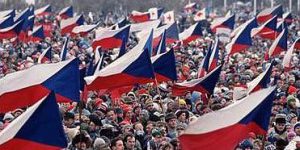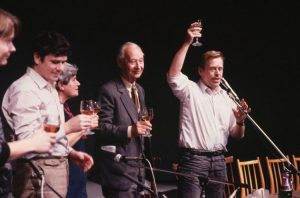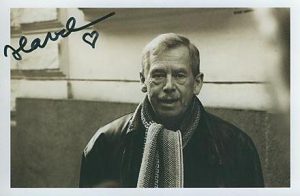The Velvet Revolution
By Tracy A. Burns
The Beginning of the Velvet Revolution – Prague: November 17, 1989
 It was International Students’ Day and the 50th anniversary of the death of Czech university student Jan Opletal, who was shot by the Nazis during a demonstration against the Germans. On November 17, 1989, Czech students started their march at Albertov, where Opletal’s funeral procession had begun. They waved political banners such as “Democracy and Law,” “Free Elections” and “Who if not us? When if not now?” Many held candles and national flags. They jingled keys. The protestors sang the Czech national anthem, “Where Is My Home?” After their arrival at poet Karel Hyněk Mácha’s grave in Vyšehrad Cemetery, they continued toward the center of the city, aiming for Wenceslas Square. The riot police blocked them on National Avenue, where demonstrators sat in the street and lit candles. The police beat them.
It was International Students’ Day and the 50th anniversary of the death of Czech university student Jan Opletal, who was shot by the Nazis during a demonstration against the Germans. On November 17, 1989, Czech students started their march at Albertov, where Opletal’s funeral procession had begun. They waved political banners such as “Democracy and Law,” “Free Elections” and “Who if not us? When if not now?” Many held candles and national flags. They jingled keys. The protestors sang the Czech national anthem, “Where Is My Home?” After their arrival at poet Karel Hyněk Mácha’s grave in Vyšehrad Cemetery, they continued toward the center of the city, aiming for Wenceslas Square. The riot police blocked them on National Avenue, where demonstrators sat in the street and lit candles. The police beat them.
The hoax
After the demonstration had broken up, it was falsely reported that police had killed a student named Martin Šmíd. (The news seemed so credible at the time that the following day Radio Free Europe even announced the death. On November 19, it became clear that the death was a hoax as citizens watched a live televised interview with Šmíd.)
November 18: the strikes
Students across the country and theatres went on strike. Instead of performances, theatres began to host public discussions. Students met with Prime Minister Ladislav Adamec to inform him of the police brutality at the march.
November 19: the birth of the Civic Forum
Theatres outside of Prague joined the strike. The Civic Forum, an association for all concerned citizens, was formed, led by playwright and dissident Václav Havel and others. The Civic Forum stated its demands, which included carrying out an investigation into the police force of November 17, ousting all politicians that had promoted the rigid Communist rule of normalization, a dark period in Czechoslovak history that had begun after the crushing of the 1968 Prague Spring. The Civic Forum also announced that all political prisoners must be released. The Public Against Violence organization, the Slovak version of the Civic Forum, was established, too.
November 20: Galleries, cinemas and other demonstrations
On Monday, secondary schools added their support to the protests. Galleries were no longer used for exhibitions but rather for printing and distributing information for the Civic Forum. Instead of showing films, cinemas let the public gather there to air their grievances about the regime. Many handbills and posters appeared at this time as the Civic Forum could not promote its activities via the mass media, which was state-run. Shop owners posted letters of protest in their windows, too. About 150,000 citizens came to Wenceslas Square to protest Communist rule. The crowd wanted to march to Prague Castle, but the police blocked their path. There were demonstrations outside of Prague, too, in Bratislava, for example.
November 21: Havel, Dubček and Kubišová
 More than 200,000 people took to the streets to protest on Tuesday, November 21. The demonstrators heard Havel speak during the revolution for the first time. Banned singer Marta Kubišová gave a stunning rendition of her “Song for Marta.” Members of the working class gave their support to the students who demanded change. That same day, the People’s Militia showed up in the center of Prague as hundreds of them took over Old Town Square. Still, the military did not mobilize. In Bratislava on November 21, some 80,000 protestors gathered while Alexander Dubček, who had been responsible for the liberal reforms of the 1968 Prague Spring, spoke. Among other topics, he argued for the release of political prisoner Ján Čarnogurský. (He would be released on November 23.) Demonstrations took place throughout the country.
More than 200,000 people took to the streets to protest on Tuesday, November 21. The demonstrators heard Havel speak during the revolution for the first time. Banned singer Marta Kubišová gave a stunning rendition of her “Song for Marta.” Members of the working class gave their support to the students who demanded change. That same day, the People’s Militia showed up in the center of Prague as hundreds of them took over Old Town Square. Still, the military did not mobilize. In Bratislava on November 21, some 80,000 protestors gathered while Alexander Dubček, who had been responsible for the liberal reforms of the 1968 Prague Spring, spoke. Among other topics, he argued for the release of political prisoner Ján Čarnogurský. (He would be released on November 23.) Demonstrations took place throughout the country.
November 22: Two-hour strike announced
The Civic Forum announced a two-hour strike on November 27. Representatives met with Adamec, who gave them his word that he would not resort to violence. Yet, he also insisted that he would preserve the socialist system. Volunteers arrived at factories to try to convince workers to go on strike on November 27. The Civic Forum added to its demands that the Communist Party’s designated role as the leading party must be abolished. November 23: “What We Want” The Civic Forum published a text of its demands, called “What We Want.” Factory workers greeted Prague Communist Secretary Miroslav Stěpán with catcalls. The Ministry of Defense said it was ready to use military force and ordered citizens to stop the demonstrations.
November 24: Resignations of top officials
The Presidium resigned, including Miloš Jakeš who had been its General Secretary. Videotapes from the November 17 police attack were broadcast on TV. Havel gave his first televised address. Television and radio employees decided to join the strike. November 25: Demonstration on Letná Plain On Saturday, Stěpán resigned, but the protestors’ demands still had not been granted in full. A massive demonstration took place on Prague’s Letná Plain, where three-fourths of a million people gather to listen to Havel and others. Adamec spoke as protestors jeered him with shouts of “Too Late.” Demonstrators gave a warm welcome to Dubček. Protests took place in Bratislava and elsewhere, too. November 26: Negotiations Prime Minister Adamec and Havel met for the first time.
November 27: The strike
The strike took place that Tuesday. Two-thirds of the population participated. Formerly banned books became available in libraries as censorship ended. November 29: Changes in the constitution
From this day, the constitution no longer stipulated that the Communist Party be the leading party of the country. Marxism-Leninism was no longer the official ideology.
December: Havel to the Castle
 Adamec and other ministers resigned. By December 7, the barbed wire fences at borders were being taken down. On December 10, the Communist Party expelled Jakeš, and President Gustáv Husák resigned. Shortly before Christmas, it was agreed that Havel would become president. Havel was unanimously elected to that post on December 29.
Adamec and other ministers resigned. By December 7, the barbed wire fences at borders were being taken down. On December 10, the Communist Party expelled Jakeš, and President Gustáv Husák resigned. Shortly before Christmas, it was agreed that Havel would become president. Havel was unanimously elected to that post on December 29.



